Standing ovation: Herzog & de Meuron’s Elbphilharmonie opens in Hamburg
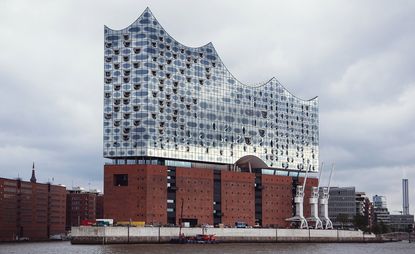
Hamburg's industrial waterfront has experienced extraordinary changes over the last century and a half, and no building better represents this than Herzog & de Meuron’s new Elbphilharmonie concert hall, which opened this week.
The multi-use structure is built on the site of the Kaiserspeicher, an 1875 neo-gothic warehouse that stood for years as the city’s most famous landmark. Almost completely destroyed in the Second World War, it was re-imagined in 1966 as the red brick Kaispeicher A, storing cocoa, tea and tobacco. Now the centrepiece of the HafenCity district, one of Europe’s most ambitious development areas, the building has been reborn for the third time as a facility containing not just three concert halls, but a hotel, apartments and public plaza.
Kaispecher A itself now contains a car park, spa facilities, restaurants, conference rooms and a 170-seat auditorium. Above that, hovering above a 4,000 sq m plaza with views around the city through vault-shaped openings, is the addition, accessible via an arched, 82m-long escalator.
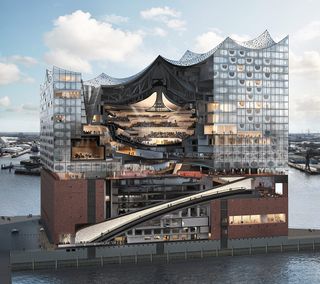
A cross-section render of the Elbphilharmonie.
The Elbphilharmonie shimmers as Hamburg’s contemporary symbol, its crystalline facade consisting of 1,100 mirrored glass panes, marked with grey reflective dots. The panes’ curvatures shift depending on their location, ranging from horseshoe-shaped recesses to fish gill-like hatches. Its tent-like roof, fitted with sparkling sequins, is made up of eight concave sections, curving with peaks and valleys like a mountain range. This profile is meant, says Herzog & de Meuron, to contrast with the horizontality of Hamburg, 'as an expression of reaching out into new territory'.
Inside the 2,100-seat Grand Hall, accessible via lofty, layered foyers cut into the building’s heart, is the complex’s centerpiece. Consisting of a series of steeply-inclined tiers, radiating on all sides from the central orchestra like sections of a hilltop vineyard, it is clad with a system called the 'White Skin', consisting of 10,000 carefully milled gypsum fibre panels made up of plaster and recycled paper. Other facilities in the new hall include a 550-seat recital hall, a 250-room hotel, and 45 private apartments.
Around it, the HafenCity continues to come to life, with renovations progressing in the Elbphilharmonie’s historic warehouse district along with futuristic new museums, offices and housing. Times have certainly changed, but the Elbphilharmonie has managed to make itself the centre of things once again.
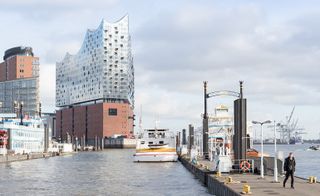
The Elbphilharmonie can be found in Hamburg’s HafenCity, the industrial port area of the city.

The roof is covered with textured circular panels.

The roof terrace opens up views across Hamburg.

Visitors enter the concert hall via a gently curving escalator.

Lofty and layered foyers guide visitors to their destinations.

The Grand Hall seats 2,100 people.
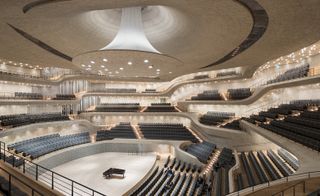
Steeply inclined tiers radiate on all sides from the central orchestra section.
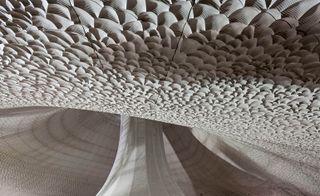
The ’White Skin’ surfacing consists of 10,000 carefully milled gypsum fibre panels.
INFORMATION
For more information, visit the Herzog & de Meuron website.
Wallpaper* Newsletter
Receive our daily digest of inspiration, escapism and design stories from around the world direct to your inbox
-
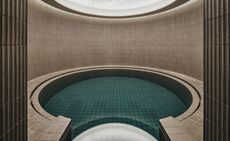 Find yourself at Six Senses Kyoto, the brand's breathtaking Japan debut
Find yourself at Six Senses Kyoto, the brand's breathtaking Japan debutSix Senses Kyoto opens its doors boasting tranquil, luxurious interiors by Blink Design Group
By Danielle Demetriou Published
-
 Shigeru Ban’s mini Paper Log House welcomed at The Glass House
Shigeru Ban’s mini Paper Log House welcomed at The Glass House'Shigeru Ban: The Paper Log House' is shown at The Glass House in New Canaan, USA as the house museum of American architect Philip Johnson plays host to the Japanese architect’s model temporary home concept
By Adrian Madlener Published
-
 Artist Mickalene Thomas wrestles with notions of Black beauty, female empowerment and love
Artist Mickalene Thomas wrestles with notions of Black beauty, female empowerment and love'Mickalene Thomas: All About Love’, a touring exhibition, considers Black female representation
By Hannah Silver Published
-
 Reethaus is a performance space conceived as ‘a place for radical presence’ in Berlin
Reethaus is a performance space conceived as ‘a place for radical presence’ in BerlinReethaus, a newly opened cultural centre in Berlin, kick-starts a fresh era for the city’s growing creative neighbourhood of Flussbad
By Ellie Stathaki Published
-
 Duplex brings two houses together as a single, raw, theatrical home in Leipzig
Duplex brings two houses together as a single, raw, theatrical home in LeipzigDuplex by Atelier ST is a raw and textured family home born of the transformation of two smaller residential buildings in Leipzig, Germany
By Ellen Himelfarb Published
-
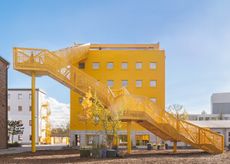 Berlin's Atelier Gardens gets bright yellow focal point within MVRDV masterplan
Berlin's Atelier Gardens gets bright yellow focal point within MVRDV masterplanThe bright yellow HAUS 1 becomes a key addition to Atelier Gardens in Berlin, part of an ever-evolving, sustainable masterplan by MVRDV
By Harriet Thorpe Published
-
 Look inside Sixth&Blanco, Herzog & de Meuron’s first project in Texas
Look inside Sixth&Blanco, Herzog & de Meuron’s first project in TexasStep inside Sixth&Blanco by Herzog & de Meuron, as the Swiss studio reveals interior images of its first ever Texas design, a forward-thinking, sustainable and mixed-use scheme
By Ellie Stathaki Published
-
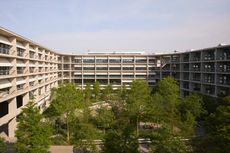 Herzog & de Meuron’s SIP Main Campus weaves together nature and sculptural concrete
Herzog & de Meuron’s SIP Main Campus weaves together nature and sculptural concreteSIP Main Campus, a new workspace by Herzog & de Meuron, completes on the Swiss-French border
By Ellie Stathaki Published
-
 Bike-tyre maker Schwalbe’s HQ embraces sustainability through design
Bike-tyre maker Schwalbe’s HQ embraces sustainability through designThe new Schwalbe office building in Germany, featuring interiors designed by Archiproba Studios, champions contemporary sustainable architecture
By Ellie Stathaki Published
-
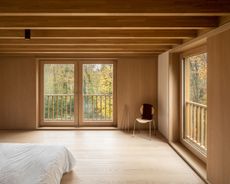 This Berlin house balances romance and strength in a scenic plot
This Berlin house balances romance and strength in a scenic plotA Berlin house transformed by O'Sullivan Skoufoglou is both romantic and protective
By Harriet Thorpe Published
-
 Royal Academy’s Herzog & de Meuron show in London spotlights architecture for care
Royal Academy’s Herzog & de Meuron show in London spotlights architecture for careThe Royal Academy of Arts launches its Herzog & de Meuron exhibition in London; we speak to them about the show, their approach to healthcare architecture and caring, and their rich body of work
By Amah-Rose Mcknight Abrams Published